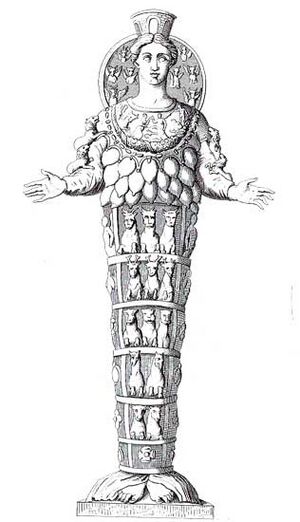Temple of Artemis facts for kids

The Temple of Artemis, also called the Artemision, was a famous Greek temple. It was built to honor an ancient form of the goddess Artemis. In Roman times, she was known as Diana. The temple was located in Ephesus, a city in modern-day Turkey.
This amazing temple was rebuilt twice after being destroyed. First, a big flood ruined it. Then, about 300 years later, someone burned it down on purpose. The final version of the temple was so grand that it became one of the Seven Wonders of the Ancient World. Sadly, by 401 AD, it was completely destroyed. Today, only parts of its foundation remain.
The very first version of a sacred place here was built during the Bronze Age. Some ancient writers believed the Amazons, a group of warrior women, built it. A flood destroyed this early temple in the 7th century BC.
A much grander temple was started around 550 BC. It was designed by the architect Chersiphron and his son Metagenes. King Croesus of Lydia paid for this huge project, which took 10 years to finish. But in 356 BC, a man named Herostratus burned it down. He wanted to be famous, even if it meant destroying something beautiful.
The last and most magnificent temple was built by the people of Ephesus themselves. It was so impressive that Antipater of Sidon included it in his list of the Seven Wonders. He wrote that when he saw it, all other wonders seemed less bright. He felt that nothing on Earth, except Mount Olympus, was as grand.
Contents
Where was the Temple of Artemis?
The Temple of Artemis was located near the ancient city of Ephesus. This area is about 50 kilometers (31 miles) south of the modern port city of İzmir in Turkey.
What did the Temple of Artemis look like?
Most of what we know about the Temple of Artemis comes from the writer Pliny. He described its size and beauty.
Pliny said the temple was 115 meters (377 feet) long and 55 meters (180 feet) wide. It was built almost entirely from white marble. This made it about three times larger than the famous Parthenon in Athens. The temple had 127 tall columns, each about 17.5 meters (57 feet) high. These columns were built in the Ionic order style.
The Temple of Artemis was also filled with amazing artworks. It had bronze sculptures made by famous Greek artists like Polyclitus, Pheidias, Cresilas, and Phradmon. These sculptors often competed to create the best art. Many of their sculptures showed Amazons, who were believed to have founded Ephesus.
The temple also featured paintings and columns covered in gold and silver. Pliny mentioned that Scopas, another famous sculptor, carved detailed pictures into the temple's columns. He also worked on the Mausoleum of Mausollos.
The main statue of Artemis inside the temple was sculpted by Endoeus. He was a student of the legendary artist Daedalus.
How was Artemis worshipped at the Temple?
The Temple of Artemis was in a very busy area. It became an important religious center. Many merchants and travelers came to it from all over Asia Minor. The temple was influenced by different beliefs. It became a symbol of faith for many different people.
The people of Ephesus also worshipped a goddess called Cybele. They combined some of their beliefs about Cybele with the worship of Artemis. This version of Artemis was quite different from the Roman goddess Diana. The religious practices at the Temple of Artemis attracted thousands of worshippers. People traveled from far away lands to gather there and honor the goddess.
Images for kids
-
The fame of the Temple of Artemis was known in the Renaissance, as demonstrated in this imagined portrayal of the temple in a 16th-century hand-colored engraving by Martin Heemskerck
-
Traditional many-breasted interpretation in a 16th-century fountain of Diana Efesina, Villa d'Este, Tivoli, Italy
See also
 In Spanish: Templo de Artemisa (Éfeso) para niños
In Spanish: Templo de Artemisa (Éfeso) para niños






